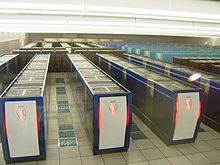Earth simulator
Two Japanese supercomputers based on vector processors are known as Earth Simulator ( Japanese 地球 シ ミ ュ レ ー タ , Chikyū shimyurēta , English “Earth simulator”) . The first parallel computer system was put into operation in 2002 at the Yokohama Institute for Earth Sciences (YES) by the NEC company.
Earth Simulator ES
For the Earth Simulator, a specially designed 3,250 m² building was erected in the Kanazawa district of the city of Yokohama ( Kanagawa Prefecture ) from 1999 . The original system, completed in 2002, was based on the SX-6 architecture from NEC and consisted of 640 computing nodes, each of which included eight vector processors and 16 GB of main memory, as well as 130 communication nodes each with a crossbar switch matrix and connections to all 640 computing nodes. Communication took place over a 12.3 Gbps fast connection network. A total of 5120 CPUs, 10 TB main memory, 700 TB hard disk and 1.6 PB tape drive storage were available.
In the TOP500 list from June 2002 to June 2004 the Earth Simulator was the fastest computer in the world with a computing power of 35.86 teraflops . In the November 2004 list, however, it was ranked by two computers (IBM's BlueGene / L and SGIs Columbia ) and was last in November 2008 only in 73rd place. It has not been listed since June 2011.
Earth Simulator ES2
In mid-November 2008 the first Earth Simulator was shut down and replaced by its successor with the officially same name (ES2). This is based on the SX-9 / E architecture from NEC and consists of 160 computing nodes, each of which includes eight vector processors and 128 GB main memory. Communication now takes place via a switch network with a fat tree topology that can transmit 128 GB / s. In total, the 1280 CPUs can access 20 TB of main memory.
The new edition made its debut in the TOP500 list in June 2009 with 122.4 TFLOPS at position 22. It has not been listed since June 2014.
The chief developer of the computer was Tadashi Watanabe .
Earth Simulator ES3
The ES2 was replaced in March 2015 by the Earth Simulator 3 (ES3), an NEC SX-ACE system with 5120 nodes.
Web links
- The homepage of the "Earth Simulator" (Japanese, English)
- Article about the Earth Simulator (English)
Individual evidence
- ↑ https://www.jamstec.go.jp/es/en/info/150601_es.html
- ↑ https://www.jamstec.go.jp/es/en/system/hardware.html
Coordinates: 35 ° 22 ′ 51 ″ N , 139 ° 37 ′ 34.8 ″ E

